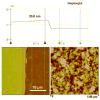Nanolayer biomaterial coatings of silk fibroin for controlled release
- PMID: 17628161
- PMCID: PMC2695962
- DOI: 10.1016/j.jconrel.2007.06.006
Nanolayer biomaterial coatings of silk fibroin for controlled release
Abstract
An all-aqueous, stepwise deposition process with silk fibroin protein for the assembly of nanoscale layered controlled release coatings was exploited. Model compounds, Rhodamine B, Even Blue and Azoalbumin, representing small molecule drugs and therapeutically relevant proteins were incorporated in the nanocoating process and their loading and release behavior was quantified. In addition, the structure and morphology of the coatings were characterized. Release studies in vitro showed that control of beta-sheet crystal content and the multilayer structure of the silk coatings correlated with the release properties of the incorporated compounds. In particular, higher crystallinity and a thicker silk capping layer suppressed the initial burst of release and prolonged the duration of release. These novel coatings and deposition approach provide a unique option to regulate structure and morphology, and thus release kinetics. The results also suggest these systems as a promising framework for surface engineering of biomaterials and medical devices to regulate the release of drugs, when considered with the all-aqueous process involved, the conformal nature of the coatings, the robust material properties of silk fibroin, and the degradability and biocompatibility of this family of protein.
Figures









Similar articles
-
Silk coatings on PLGA and alginate microspheres for protein delivery.Biomaterials. 2007 Oct;28(28):4161-9. doi: 10.1016/j.biomaterials.2007.05.036. Epub 2007 Jun 20. Biomaterials. 2007. PMID: 17583788 Free PMC article.
-
Natural Non-Mulberry Silk Nanoparticles for Potential-Controlled Drug Release.Int J Mol Sci. 2016 Dec 1;17(12):2012. doi: 10.3390/ijms17122012. Int J Mol Sci. 2016. PMID: 27916946 Free PMC article.
-
Calcium alginate beads embedded in silk fibroin as 3D dual drug releasing scaffolds.Biomaterials. 2009 Oct;30(28):5170-7. doi: 10.1016/j.biomaterials.2009.05.072. Epub 2009 Jun 23. Biomaterials. 2009. PMID: 19552952
-
Preparation of silk fibroin carriers for controlled release.Microsc Res Tech. 2017 Mar;80(3):312-320. doi: 10.1002/jemt.22606. Epub 2015 Dec 6. Microsc Res Tech. 2017. PMID: 26638113 Review.
-
Silk Fibroin as a Green Material.ACS Biomater Sci Eng. 2021 Aug 9;7(8):3530-3544. doi: 10.1021/acsbiomaterials.1c00493. Epub 2021 Jul 14. ACS Biomater Sci Eng. 2021. PMID: 34260194 Review.
Cited by
-
Silk fibroins in multiscale dimensions for diverse applications.RSC Adv. 2020 Sep 8;10(55):33227-33247. doi: 10.1039/d0ra03964k. eCollection 2020 Sep 7. RSC Adv. 2020. PMID: 35515035 Free PMC article. Review.
-
Electrobiofabrication: electrically based fabrication with biologically derived materials.Biofabrication. 2019 Apr 26;11(3):032002. doi: 10.1088/1758-5090/ab06ea. Biofabrication. 2019. PMID: 30759423 Free PMC article. Review.
-
Silk-based biomaterials for sustained drug delivery.J Control Release. 2014 Sep 28;190:381-97. doi: 10.1016/j.jconrel.2014.05.059. Epub 2014 Jun 5. J Control Release. 2014. PMID: 24910193 Free PMC article. Review.
-
Silk-based stabilization of biomacromolecules.J Control Release. 2015 Dec 10;219:416-430. doi: 10.1016/j.jconrel.2015.09.037. Epub 2015 Sep 25. J Control Release. 2015. PMID: 26403801 Free PMC article. Review.
-
Mechanisms of monoclonal antibody stabilization and release from silk biomaterials.Biomaterials. 2013 Oct;34(31):7766-75. doi: 10.1016/j.biomaterials.2013.06.039. Epub 2013 Jul 13. Biomaterials. 2013. PMID: 23859659 Free PMC article.
References
-
- Fredin NJ, Zhang J, Lynn DM. Surface analysis of erodible multilayered polyelectrolyte films: nanometer-scale structure and erosion profiles. Langmuir. 2005;21(13):5803–5811. - PubMed
-
- Forzani ES, Perez MA, Lopez Teijelo M, Calvo EJ. Redox driven swelling of layer-by-layer enzyme-polyelectrolyte multilayers. Langmuir. 2002;18(25):9867–9873.
-
- Thierry B, Winnik FM, Merhi Y, Silver J, Tabrizian M. Bioactive coatings of endovascular stents based on polyelectrolyte multilayers. Biomacromolecules. 2003;4:1564–1571. - PubMed
-
- Hammond P. Form and function in multilayer assembly: new applications at the nanoscale. Adv Mater. 2004;16:1271–1293.
Publication types
MeSH terms
Substances
Grants and funding
LinkOut - more resources
Full Text Sources
Other Literature Sources

